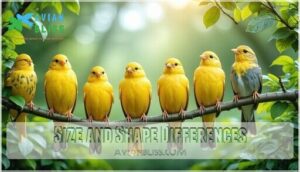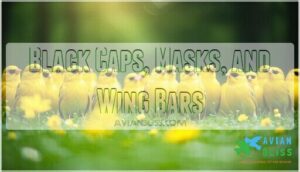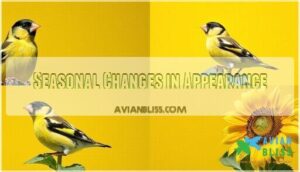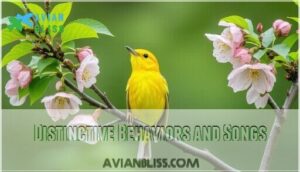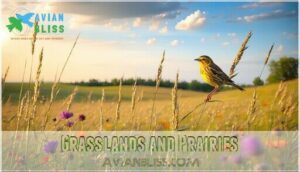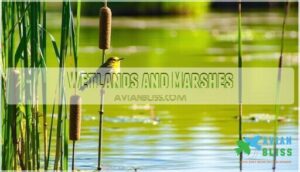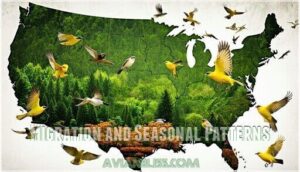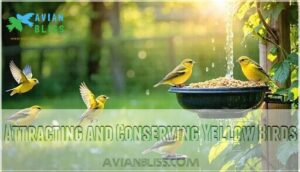This site is supported by our readers. We may earn a commission, at no cost to you, if you purchase through links.
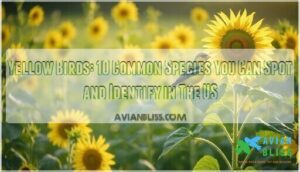
Each species has unique identifying features, preferred habitats, and migration patterns that determine when and where you’ll encounter them throughout the seasons.
Table Of Contents
- Key Takeaways
- Common Yellow Birds in The United States
- Identifying Yellow Birds: Key Features
- Habitats and Distribution of Yellow Birds
- Migration and Seasonal Patterns
- Attracting and Conserving Yellow Birds
- Frequently Asked Questions (FAQs)
- What are the yellow birds called?
- What happened to Murph in yellow birds?
- Is yellow birds a true story?
- What was the point of the Yellow Birds movie?
- What are the best binoculars for birdwatching?
- What time of day are yellow birds most active?
- Are there any yellow birds that dont migrate?
- What do yellow birds eat?
- Are there any yellow birds outside of North America?
- What sounds do yellow birds make besides singing?
- Conclusion
Key Takeaways
- You’ll identify yellow birds by watching for key features like size, plumage patterns, black markings, and seasonal color changes that distinguish species like goldfinches, warblers, and meadowlarks.
- You can find yellow birds in diverse habitats across America—from backyard feeders and city parks to forests, grasslands, wetlands, and prairies, depending on each species’ preferences.
- You’ll attract more yellow birds to your yard by offering nyjer and sunflower seeds, planting native fruiting bushes, providing fresh water, and avoiding pesticides that harm their food sources.
- You’re witnessing migration patterns where some yellow birds travel thousands of miles seasonally, while others stay year-round, with climate change increasingly affecting their traditional routes and timing.
Common Yellow Birds in The United States
You’ll spot a variety of yellow birds across the United States, from bright goldfinches in your backyard to warblers in wooded areas.
Each species stands out with unique markings and behaviors, making identification both interesting and rewarding.
American Goldfinch
Ever wondered why the American Goldfinch stands out among yellow birds? Its yellow body and black wings shine brightest in summer, thanks to dramatic plumage changes. This seedeating bird loves sunflower and thistle seeds, showing unique diet preferences.
Goldfinches flash brilliant yellow against
Watch for their social behavior—flocking in groups, especially during winter survival. Their nesting habits favor open fields, making them easy to spot.
Yellow Warbler
If you spot a Yellow Warbler singing from a bush, you’re seeing one of the most widespread yellow bird species in the US. American Yellow Warblers show bright yellow plumage, chestnut streaks, and distinct breeding behavior.
With over 30 Warbler subspecies, their diet variations and nest parasitism threats shape their conservation status and daily survival.
Western Meadowlark
If you’re curious about yellow birds, Western Meadowlarks are hard to miss. Their bright yellow plumage and black V-shaped band stand out in grasslands. Listen for the famous Meadowlark Song, a clear whistle.
Meadowlarks nest on the ground, eat insects and seeds, and face Habitat Loss. Their Conservation Status is stable, but watching them always feels special.
Prothonotary Warbler
If you wander near a swamp habitat in spring, you might catch the Prothonotary Warbler’s flash of gold. These yellow birds nest in tree cavities and have a Conservation Status of Least Concern.
During breeding season, listen for their loud vocalizations. Their diet includes insects and snails. Unlike the Yellow Warbler, Prothonotaries prefer wet woods and flooded forests.
Evening Grosbeak
The Evening Grosbeak stands out among yellow birds with its chunky yellow body and bold black wings. You’ll often spot them at bird feeders, especially during winter. Grosbeak identification is easy thanks to their thick bills and social behavior. They love seeds and fruit, making diet preferences simple. Their conservation status depends on habitat needs and changing forest landscapes. Habitat loss endangers many small yellow birds.
- Notice their vibrant yellow plumage
- Listen for their cheerful, chatty flocks
- Watch them crack seeds with powerful bills
Other Notable Yellow Bird Species
You’ll sometimes cross paths with rare yellow birds like the YellowHeaded Blackbird or tropical yellow birds such as the Bananaquit. Island yellow birds often show unique adaptations you won’t see elsewhere.
Some yellow warblers and the endangered YellowThroated Vireo remind us that not every yellow body is common. The Yellow-breasted Chat is set apart from other warblers due to its unique characteristics.
Keep an eye out—these species are real treasures!
Identifying Yellow Birds: Key Features
You can spot yellow birds by paying attention to their size, shape, plumage patterns, and unique markings like black caps or wing bars. Seasonal changes and distinctive songs also help you tell one species from another with confidence.
Size and Shape Differences
When you’re sizing up yellow birds, pay attention to Bill Morphology, Tail Length, Body Mass, and Wing Shape. These Identifying Characteristics can make or break your ID game.
Sexual Dimorphism means males and females of some bird species look different. Compare their size and shape, not just plumage or markings, to spot subtle differences among yellow birds.
Plumage Patterns and Markings
After checking size and shape, you’ll want to look at plumage patterns and markings. Plumage coloration isn’t just for show—it helps with camouflage and shows off sexual dimorphism. Notice feather structure and molting patterns, too.
Spot these features on yellow birds:
- Bright yellow body with black wings
- Streaks or spots on the chest
- Contrasting markings around the face
These patterns aid in quick bird identification.
Black Caps, Masks, and Wing Bars
When you’re sorting out yellow birds, pay close attention to Cap Coloration and Mask Variations. A Black Cap, like on the American Goldfinch, stands out. Some, such as Common Yellowthroats, sport a Black Mask.
Wing Bar Function is also key—White wing bars or Black Wings help with Species Markings and Plumage Distinctions, making identification much easier.
Seasonal Changes in Appearance
Spotting yellow birds can get tricky when their plumage shifts with the seasons. Adult males flaunt bold Breeding Plumage, while Adult females and Juveniles show duller Winter Colors or muted markings. Molting Patterns and Camouflage Changes help them blend in. Keep an eye on Juvenile Appearance—young birds often look patchy before their true yellow shines through.
Distinctive Behaviors and Songs
After plumage changes, watch for unique behaviors and songs to spot yellow birds. Notice how a yellow songbird’s Vocal Mimicry or Mating Rituals set it apart. Listen for Song Complexity and observe Foraging Techniques. You’ll find:
- Social Interactions like aerial chases
- Insect eaters hopping between branches
- Yellow warblers singing “sweet-sweet-sweet”
- Western Meadowlarks’ melodious tunes
Habitats and Distribution of Yellow Birds
You’ll find yellow birds in a wide range of habitats, from dense forests and open grasslands to wetlands and city parks across the United States.
Knowing where each species lives and how far they range helps you spot and identify them more easily.
Forests and Woodlands
When you’re searching for Yellow Birds in woodland habitats, keep an eye out for canopy dwellers like the Townsends Warbler and understory birds such as Yellow Warblers. Coniferous forests offer plenty of insect prey, making them prime spots for nesting ecology.
Forest conservation matters—healthy woods mean more birds. Listen for quick chirps above and watch for flashes of yellow below.
Grasslands and Prairies
You’ll find Yellow Birds in the United States thriving among native grasses and open meadows, especially where Prairie Restoration is underway. Listen for Grassland Birdsong—Meadowlarks, both Eastern and Western, are stars here.
Habitat Fragmentation and Grazing Impacts can challenge these birds, so intact prairies matter. Spot their vibrant colors as they dart through tall grass, always busy.
Wetlands and Marshes
Wetlands and marsh habitats are prime real estate for yellow birds like the Prothonotary Warbler, Common Yellowthroat, Yellow Warbler, and Yellow-throated Warbler. These insect eaters thrive where water quality is good, and Wetland Conservation matters.
Habitat loss threatens their avian diet and nesting spots. Keeping marshes healthy benefits both bird populations and your birdwatching adventures.
Urban and Suburban Areas
You don’t have to trek through wetlands to spot yellow birds—just step into your backyard or stroll down a city street. Urban Habitats and Suburban Feeders attract species like the American Goldfinch, drawn to backyard bird feeders stocked with sunflower seeds. Backyard Birding lets you watch City Migration up close, highlighting Human Impact on these adaptable Backyard Birds.
- Watch goldfinches munch sunflower seeds
- Spot warblers in city parks
- Listen for cheerful meadowlarks at dawn
- Marvel at birds thriving near busy roads
Regional Range Maps
When you’re checking Range Maps for yellow birds in the United States, you’ll spot the American Goldfinch coast-to-coast, while Yellow Warblers shift northward due to climate change effects. Historical range shifts and habitat loss impact where you’ll see these birds. Citizen science boosts Range Map accuracy. Here’s a quick look:
| Species | Range Map Accuracy | Habitat Loss Impact |
|---|---|---|
| American Goldfinch | High | Moderate |
| Yellow Warbler | High | High |
| Western Meadowlark | Moderate | Severe |
| Prothonotary Warbler | Moderate | High |
| Evening Grosbeak | Variable | Moderate |
Migration and Seasonal Patterns
You’ll notice that many yellow birds change where they live as the seasons shift, with some traveling thousands of miles between breeding and wintering grounds. Others stay put year-round, so understanding these patterns can help you predict which species you’ll see in your area throughout the year.
Long-Distance Migratory Species
As you explore Yellow Birds in United States, some species like the American Goldfinch, Yellow-Rumped Warbler, and Nashville Warbler clock thousands of miles each year. Their Migration Triggers include daylight shifts and food supply, while Navigation Methods rely on stars and the earth’s magnetic field. Climate Change and Conservation Challenges impact these journeys.
- Stopover Ecology shapes migration routes
- Range Map shows travel patterns
- Conservation efforts matter
Year-Round Residents
While some yellow birds travel far, others stick around all year. You’ll spot Yellow Birds in the United States like the American Goldfinch using Resident Adaptations to handle Winter Survival in Local Habitats. Their Yellow Body and Identifying Characteristics make them easy to find on any Range Map. These birds maintain Population Stability and showcase unique Breeding Habits for year-round Bird Watching.
Understanding established flyway patterns is essential for identifying migratory species.
Breeding and Wintering Grounds
While year-round residents stay put, migratory yellow birds follow predictable patterns between their summer breeding grounds and winter territories. Most species nest in coniferous forests and successional field habitats across northern United States before heading south. Understanding these migration routes helps explain their seasonal appearances in your area.
- Nesting Habitats in Canada provide perfect nurseries for raising young
- Winter Survival depends on finding reliable food sources in warmer climates
- Breeding Success requires specific vegetation for nest-building and protection
- Habitat Loss threatens both breeding and wintering sites across their Range Map
Climate Impacts on Migration
Climate change is reshaping how Yellow Birds navigate their journeys across the United States. Spring arrives up to 14 days earlier, creating Migration Timing mismatches with food sources. Shifting Ranges force species northward as Habitat Loss accelerates. Extreme Weather and Food Scarcity challenge traditional Summer Breeding Grounds. Bird Watching enthusiasts notice these changes on Range Maps, making conservation efforts essential for survival.
Many birds are adjusting their migration habits, with some arriving at their spring nesting grounds about one to two days earlier per decade.
Attracting and Conserving Yellow Birds
You can transform your yard into a haven for yellow birds by providing the right food, shelter, and safe environment they need to thrive.
Creating bird-friendly spaces brings these vibrant species closer to home and also helps maintain healthy populations across North America through essential conservation efforts that are critical to their well-being.
Bird Feeders and Food Sources
You’ll attract more yellow birds by offering their favorite foods. Nyjer seeds draw American Goldfinches, while sunflower seeds appeal to Evening Grosbeaks. Tube feeders work best for smaller species with bright yellow plumage. Don’t forget suet feeders for insect-eating warblers. Specialized feeders can further augment your bird-feeding setup.
Fresh water sources and native fruiting bushes provide natural foods year-round, especially important during winter feeding periods.
Native Plants and Nesting Sites
Beyond feeders, creating natural habitat starts with plant selection. Choose native species that provide year-round resources for yellow birds across the United States.
- Fruiting bushes like elderberry and serviceberry offer seeds and nesting cover
- Nectar-producing flowers such as sunflowers attract insects that feed yellow warblers
- Dense shrubs provide nesting materials and site protection for ground-nesting birds
Smart birdhouse placement and habitat improvement support species with specific identifying characteristics and nesting preferences. Many gardeners find success with various bush products to attract birds.
Avoiding Pesticides and Hazards
Pesticide Exposure threatens yellow birds through contaminated insects and seeds. Window Collisions kill millions annually – place decals on glass surfaces. Keep cats indoors to reduce Predator Risks for ground-nesting birds. Remove Lead Poisoning sources like old paint chips.
Plant nectar-producing flowers away from high-traffic areas. These simple steps protect species with Yellow Body plumage and distinctive Identifying Characteristics throughout the United States while preventing Habitat Contamination.
Conservation Challenges and Efforts
You’re witnessing a bird crisis firsthand. About one-third of America’s yellow birds face threats from Habitat Loss and Climate Change. Invasive Species disrupt their food sources, while ground-nesting birds suffer increased predation.
However, Protected Areas and restoration projects offer hope. The Neotropical Migratory Bird Conservation Act funds critical research. Your participation in Citizen Science helps track population trends through Range Map data and plumage observations, supporting conservation efforts across the United States.
To combat these declines, regenerative agriculture strategies can promote healthier habitats.
Citizen Science and Birdwatching Tips
Backyard Birding enthusiasts can contribute to Conservation Impact through citizen science projects. You’ll help with Data Collection by reporting sightings to apps like eBird, documenting plumage, markings, and identifying characteristics.
Use Range Map tools to verify locations across the United States. These efforts tackle ID challenges while supporting research that protects yellow bird populations nationwide.
Enhancing your experience is easy with specialized birding apps.
Frequently Asked Questions (FAQs)
What are the yellow birds called?
Like a painter’s palette bursting with sunshine, you’ll discover over thirty yellow bird species across America. They’re called American Goldfinches, Yellow Warblers, Western Meadowlarks, Common Yellowthroats, and Lesser Goldfinches, among others.
What happened to Murph in yellow birds?
I can’t answer your question about Murph in "Yellow Birds" because that appears to reference a specific book, movie, or story that isn’t covered in the provided knowledge about actual yellow bird species and their characteristics.
Is yellow birds a true story?
Fiction mirrors truth: "The Yellow Birds" draws from Kevin Powers’ Iraq War service but isn’t autobiography. You’ll find real combat emotions woven through invented characters and events.
What was the point of the Yellow Birds movie?
You’re exploring the movie’s deeper meaning about war trauma. "The Yellow Birds" offers a poignant meditation on truth, memory, and war’s psychological effects. The film examines how soldiers process trauma and the gap between combat reality and civilian understanding.
What are the best binoculars for birdwatching?
Through history’s lens, choosing binoculars for birdwatching isn’t rocket science. You’ll want 8×42 models – they’re the sweet spot for magnification and light gathering.
Look for brands like Zeiss, Swarovski, or Vortex for quality optics that won’t break the bank.
What time of day are yellow birds most active?
You’ll spot yellow birds at their busiest just after sunrise and before sunset. **These golden hours are prime time for feeding, singing, and socializing.
** If you’re patient, you’ll catch their brightest feathers in action.
Are there any yellow birds that dont migrate?
Yes, several yellow birds don’t migrate. American Goldfinches in warmer regions stay year-round, as do many Western Meadowlarks in western and midwestern states. Lesser Goldfinches also remain in their territories throughout the year.
What do yellow birds eat?
Birds of a feather flock together, especially at mealtime. You’ll find yellow birds munching on seeds, insects, berries, and nectar.
Their diet shifts with the seasons, so you’ll see them hunting bugs or snacking on sunflower seeds.
Are there any yellow birds outside of North America?
You’ll find yellow birds across every continent except Antarctica. Europe has golden orioles, Africa boasts yellow canaries, Asia features yellow-crowned bulbuls, Australia has golden whistlers, and South America hosts many yellow tanagers and flycatchers.
What sounds do yellow birds make besides singing?
You’ll hear yellow birds making alarm calls when threatened, contact calls to communicate with flock members, and various chirps during feeding or territorial disputes beyond their melodic songs.
Conclusion
Spotting yellow birds transforms any outdoor experience into an adventure. Identifying these species strengthens your connection with nature. Supporting their conservation guarantees future generations can enjoy their bright presence.
You’ve learned to recognize distinctive features, preferred habitats, and seasonal behaviors of America’s most common yellow birds. Whether you’re watching American Goldfinches at your feeder or listening for Yellow Warblers in nearby woods, these identification skills will enrich every birdwatching experience you encounter.

